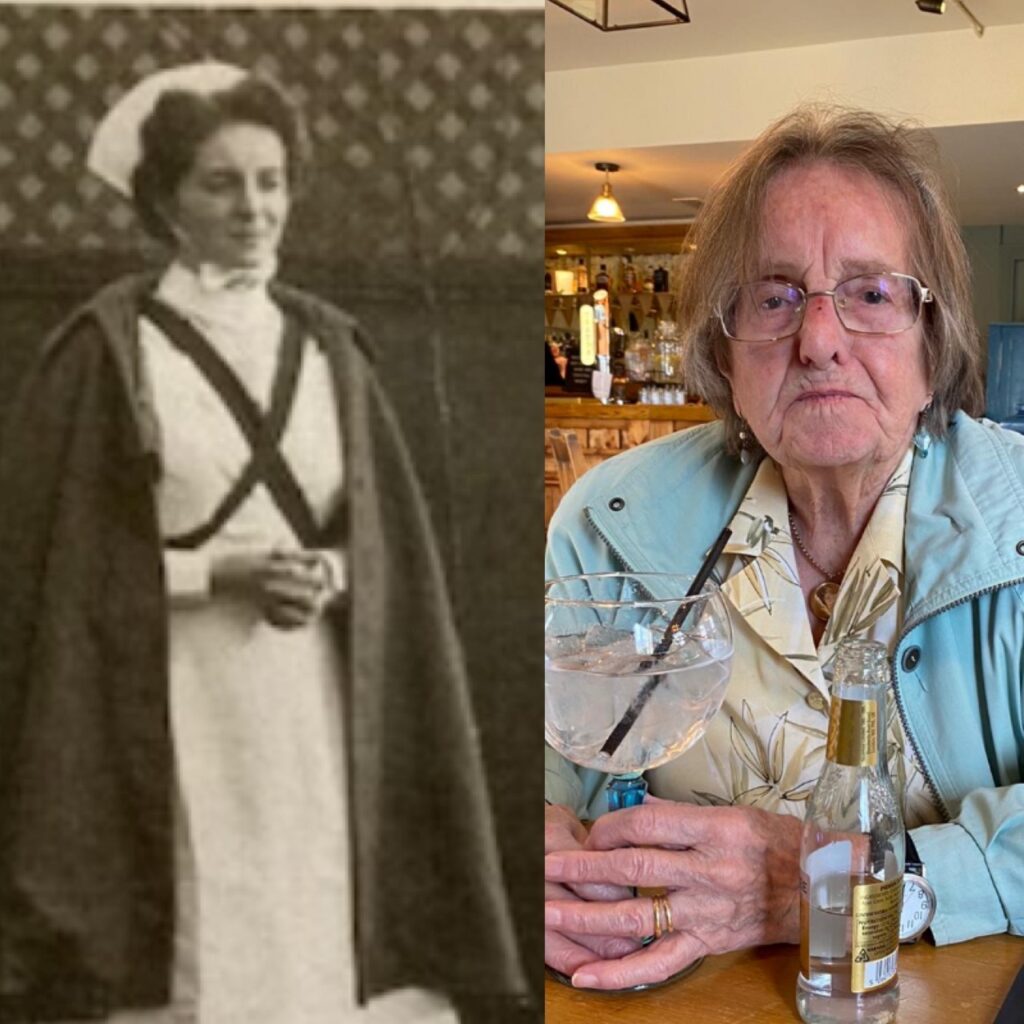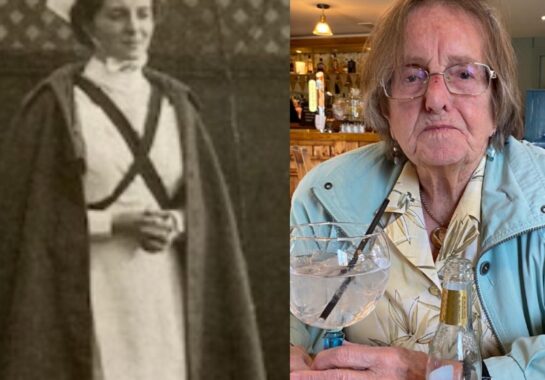Joan turns 100 this month and looks back at her time as a Nurse at Alder Hey during Second World War.
I came to Alder Hey in August 1939 just before the war was declared, as a probationer. I was 17 at the time. We all lived in the nurses home, then supervised by the home sister who prowled round at all times to see that all was in order, though after a 14 hour day I don’t know what wrong doing she expected to find- we thought only of sleep! If your room was on the ground floor, it was always possible that a tap on the window, after the 10 o clock deadline would herald someone desperate to be let in.
When the war was declared, the top floor of the hospital was cleared and it was felt that in the event of an air raid, it would be difficult to bring sick children down three flights. There was a children’s home called Olive Mount and the children from there were sent to safety- I think somewhere in Wales and our convalescent patients used that accommodation.

At that time, electricity was made on site, at our own coal fired plant, which meant that if the main power station was out of action, we would still be operational.
My most vivid memories were of what came to be known as the May blitz, when casualties from Liverpool were brought out to Alder Hey to be treated and sorted as appropriate and sent on to other hospitals to clear space in A1 and B1 for the next night. I was on night duty at the time and we came off duty, had breakfast and then went on to lend a hand as it was essential that the work was done in time to clear the wards for the next night.
We had an AA gun at either end of the site and were told that they did not expect to hit anything, but that they served to keep enemy planes away from us. There were air raid shelters to which we were supposed to go if a raid happened off duty, but on duty we stayed with the children.
I was on isolation ward at the time and remember going out on to the fire escape from where we could actually watch the dog fights going on between our planes and the German ones.
The events of Dunkirk will be familiar to you all, though at the time we knew little of what went on. You may not know that the Royal Iris and Royal Daffodil played their part and that at the end, they came back to Liverpool full of the people they had rescued. We did not know what had happened but many of them were French and spoke no English and a call went out for any member of staff who spoke French to go to help the army staff who were in charge. They had been brought to Alder Hey presumably because the top floor wards were at the same time empty and could accommodate the numbers.
Army huts were built as wards at the end of the hospital, staffed of course by RAMC.
There was an epidemic of diphtheria a few years into the war and the fever hospital was full, so a deal was done with the army so that we could use two of their wards, access to which was in the open air and separated from each other, so that it was possible to segregate the infection.
I was acting staff on one of the wards at the time. Most of the children had, I seem to recall, been immunised to some extent and after the initial few days were not seriously ill, though of course carried the infection and had very sore throats. They seemed to get used to a 10ml syringe into little bottoms! In all we had about 70 children through the ward whilst it was open.
I was on dury on pancake Tuesday and it happened to be an egg day. We did not have enough eggs to give one to each child and the idea as that we should scramble them to give each child some on toast. However, I came up with the idea that we should made pancakes, as many as we could. Sister said that she would order flour and enough extra milk I suppose, if I was prepared to do the job. I therefore spent the afternoon in the ward kitchen, frying pan in hand and speaking to parents at the kitchen door. The children were thrilled with the whole enterprise and of course had their share of the scarce supply of eggs.
I do not know how you admit children nowadays but may be interested to hear how it was. An entry was made in the admission book of the state of the child on admission, in red ink if the child was not infected with nits and head lice. They were then bathed and if in a fit enough state for this, in winter some were sewn into a vest, often with newspaper underneath for the duration of the cold weather. We removed these garments, as you can imagine the dirt and smell was not what we wanted on the wards. On one occasion I was given the task of bathing one toddler, and when his hair was washed the whole of the dark hair came off in my hand along with the dirt which was holding it on. He was left with beautiful blond curls.
On many occasions the mere fact that a sick child was, perhaps for the first time in his life, warm and clean, helped in his recovery. Anti-biotics were of course not yet available, but the medicine we had meant that children recovered who would not have done only a short time before.
It was not always clear if the person bringing in the child was actually the mother, or as often happened, a grandmother or aunt. On one occasion, asked the age of the child, we were told aged 3. Sister thought the child was rather small, so he was put into a cot. The next day an anxious relative arrived to say that he was not little Billy, but little Tommy and he was only 2!
Some of you may be old enough to remember the stalls at the back of the old market and the shawled woman known to us as the ‘lemon ladies’ as that was what they sold. We had a small boy, in a cot, as his age was indeterminate. He had been admitted with a chest infection but had been kept in, as he was a textbook case of rickets and the students came to see him. He had been brought in by one of the shawl women and on visitors’ day she presented Sister with a bag of oranges!! Where she had obtained them, it was better not to ask, and she said they were not for the children- but for ‘you luv.’
At that time, TB bones were very prevalent and as we had no drugs to combat the disease, they were immobilised on specially made frames or in Thomas splints. The orthopaedic wards were rather jolly places as the patients were not ill in the same way as in other wards.
One never to be forgotten nights, one of the older boys Eddie had disappeared from his bed. He was known to have a habit, in daytime, of trying to climb on to the windowsills complete with Thomas splint. However, this time, in the middle of the night, he was found with several of his friends under the beds in the day room, which was closed at night because it was not blacked out. They were playing poker, with more money than I earned in a month. He had arrived there on his good one leg and two hands under the beds in the ward without disturbing patients or staff! I often wonder what became of him. He was ingenious enough to do well at anything he set his mind to!
There must be many more tales from those days, which other-alas few will recall, perhaps to add to this if it is of interest to the young ones who came after.
